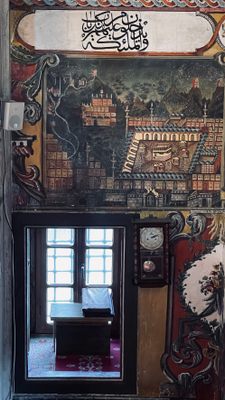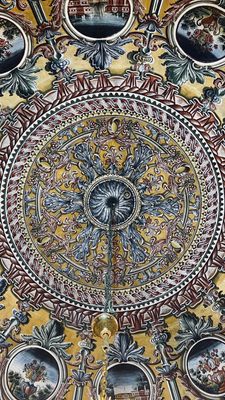About
The exterior of Xhamia e Larme (Painted Mosque) mosque is adorned with illustrated, colorful rectangles that look like giant, artisanal playing cards, and the interior is no less intricate. According to an inscription above the main entrance to the mosque, the original Xhamia e Larme mosque was built in 1485, but it was destroyed in 1689 by a fire during a battle with Austrian forces. A newer version of Xhamia e Larme was built in 1833 under the aegis of Abdurrahman Pasha.
Pasha expanded the mosque into a 10 meter-by-10 meter square. Out of respect for the minaret’s original orientation, builders placed the tower halfway through one of the structure’s side walls, rather than in the corner of the building as is custom. Thirty stained glass windows ring the mosque in an almost-symmetrical formation, letting colorful sunlight into the room and projecting patterns on the interior walls. To make the mosque appear symmetrical, artists painted a window on the wall where the minaret interrupts the place of an actual window.
Given its age and architecture, Xhamia e Larme would have been remarkable in its own right, but the decorations make it a place of immense cultural and artistic value. Abdurrahman Pasha called on artists from Debar (Dibra in Albanian) to decorate both the interior and the exterior of the mosque. On the exterior walls between the wooden windows, they tastefully inserted intricate floral and geometric patterns divided into panes. A large six-point star stands out on the ceiling of the porch.
The interior decorations are simply stunning. Floral and geometric motifs dominate, but the corbeled dome and the upper section of the walls also boast depictions of famous urban landscapes and twelve medallions with the exquisite, calligraphic names of twelve prophets. Each front-facing upper window has an internal semi-circular balcony whose design is enhanced by rich and colorful decorations.
At the back of Xhamia e Larme is a graveyard with ancient tombs. The oldest ones date back to the 16th century, and they belong to Hurshide and Mensure, daughters of an Anatolian Pasha.
Related Tags
Community Contributors
Added By
Published
November 8, 2022























































